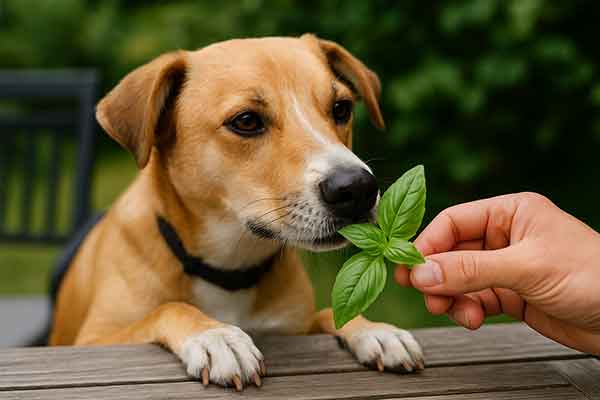Is Basil Bad for Dogs? Safety, Risks & Proper Usage
Basil is a beloved herb used in countless human dishes—from fresh Caprese salads to fragrant pestos. But what about our furry friends? Is basil bad for dogs? Fortunately, the answer is no—basil is not toxic to dogs and, when fed properly, it can even offer health benefits. However, like many human foods, basil should be given in moderation, and there are certain precautions to consider. In this article, we’ll explore whether basil is bad for dogs, how it affects their health, and the best ways to serve it safely.
Table of Contents
- Is Basil Safe for Dogs?
- Health Benefits of Basil for Dogs
- When Is Basil Bad for Dogs?
- How Much Basil Can Dogs Eat?
- How to Safely Serve Basil to Dogs
- Other Dog-Safe Herbs
- FAQ
Is Basil Safe for Dogs?
Yes, basil is generally safe for dogs and is not considered toxic according to the ASPCA. Fresh or dried basil can be offered in small amounts as a flavorful and potentially health-boosting treat. The key is moderation and avoiding any preparations that include harmful additives like garlic, onion, salt, or oil.
There are several varieties of basil—sweet basil, Thai basil, lemon basil, and holy basil (Tulsi)—and all are safe for dogs in small quantities, though sweet basil is the most commonly used and studied.
Health Benefits of Basil for Dogs
When used in appropriate portions, basil can provide several health perks for dogs:
1. Antioxidant Properties
Basil is rich in antioxidants like flavonoids and polyphenols, which help protect cells from free radical damage and may support healthy aging.
2. Anti-Inflammatory Effects
The essential oils in basil, including eugenol and linalool, have been linked to anti-inflammatory effects that may benefit dogs with arthritis or inflammation-related issues.
3. Immune System Support
With its antibacterial and antifungal properties, basil may help strengthen your dog’s immune response and overall wellness.
4. Calming Effects
Holy basil (Tulsi) is traditionally used to help reduce stress. While research in dogs is limited, some holistic veterinarians believe it may have mild calming properties for anxious pets.
5. Digestive Aid
Basil may assist with mild gas, bloating, or digestive discomfort due to its soothing nature on the gastrointestinal system.

When Is Basil Bad for Dogs?
Despite its benefits, there are situations where basil may not be a good choice for your dog:
1. Overfeeding
Too much basil can irritate your dog’s digestive tract and lead to vomiting or diarrhea. Always serve in moderation.
2. Allergies or Sensitivities
Though uncommon, some dogs may be allergic to basil. Watch for signs like itching, swelling, hives, or gastrointestinal upset after introduction.
3. Essential Oil Extracts
Concentrated basil oils or tinctures can be far too potent for dogs and may cause toxicity, especially when ingested or applied to the skin. Always stick to fresh or dried basil leaves only.
4. Store-Bought Dishes
Never give your dog basil-containing human foods like pesto, sauces, or herb mixes that contain garlic, onions, salt, or cheese—all of which are toxic or unhealthy for dogs.
How Much Basil Can Dogs Eat?
Portion control is essential when offering basil to dogs. Here’s a general guide:
- Small dogs: 1–2 fresh basil leaves or a small pinch of dried basil
- Medium dogs: 2–3 leaves
- Large dogs: 3–5 leaves
Start with a tiny amount and monitor your dog’s reaction. If they show no negative side effects, you can occasionally add basil as a supplement or meal topper.
How to Safely Serve Basil to Dogs
If you’d like to add basil to your dog’s routine, here are some safe ways to prepare it:
- Chopped fresh basil: Sprinkle on top of your dog’s kibble or homemade meals
- Dried basil: Add a pinch for flavor or into dog-friendly biscuit recipes
- Frozen basil cubes: Blend basil with water or broth and freeze in ice cube trays as summer treats
Important: Always wash basil thoroughly before feeding, and avoid giving any part of the plant that has been treated with pesticides or herbicides.
Other Dog-Safe Herbs
In addition to basil, these herbs are also safe for dogs in small amounts:
- Parsley: Freshens breath and contains vitamins A, C, and K
- Cilantro: Contains antioxidants and supports digestion
- Thyme: Offers antimicrobial benefits
- Dill: Can help reduce gas and improve digestion
- Rosemary: Safe in very small quantities but avoid for dogs with epilepsy
Always introduce herbs one at a time and consult your vet if your dog is on medication or has existing health conditions.
FAQ
Is basil toxic to dogs?
No, basil is not toxic to dogs. It is safe in small amounts and may even provide some health benefits. However, large quantities or concentrated forms like oils should be avoided.
Can dogs eat basil daily?
There’s no need to feed basil daily. While it’s safe in small doses, it should be offered occasionally as a supplement or treat—not a staple.
Can dogs eat pesto?
No. Most pesto recipes contain garlic, cheese, and oil, which are unsafe or unhealthy for dogs. Only plain, fresh basil without additives is safe.
What kind of basil is best for dogs?
Sweet basil is the most common and suitable variety for dogs. Thai or lemon basil are also safe but may be stronger in flavor.
What happens if my dog eats too much basil?
Too much basil may cause an upset stomach, including vomiting or diarrhea. In rare cases, an allergic reaction may occur. If symptoms are severe or persist, consult your vet.
Conclusion
Is basil bad for dogs? Not at all—basil is safe and even beneficial in small amounts when served properly. It offers antioxidant, anti-inflammatory, and digestive benefits that can support your dog’s health. However, it’s important to avoid giving large amounts or any dish containing harmful ingredients like garlic or salt.
As with any new food, introduce basil slowly and observe your dog’s response. When in doubt, check with your veterinarian before making any changes to your dog’s diet. A small sprinkle of fresh basil might be just the boost your pup’s bowl needs!


